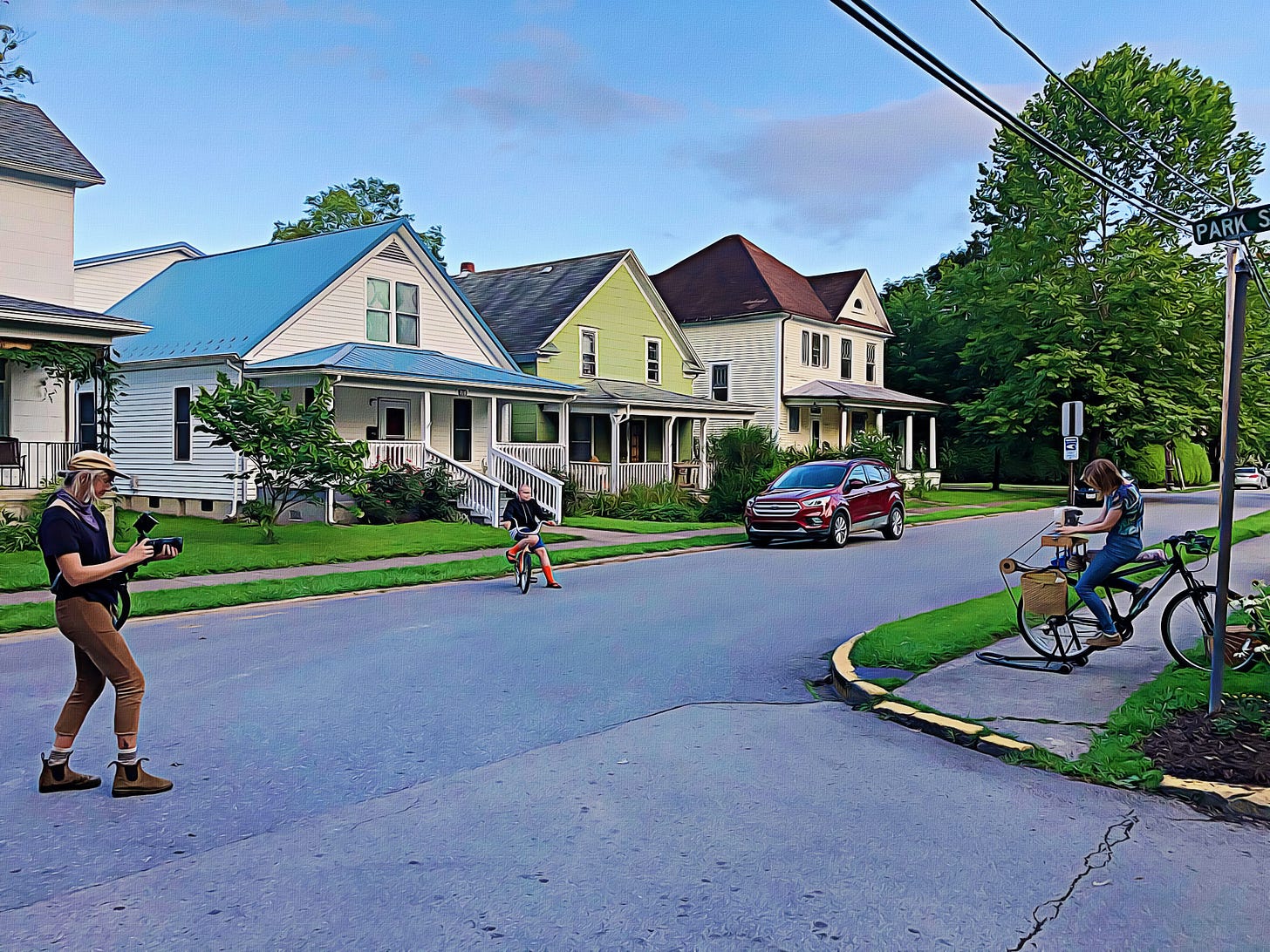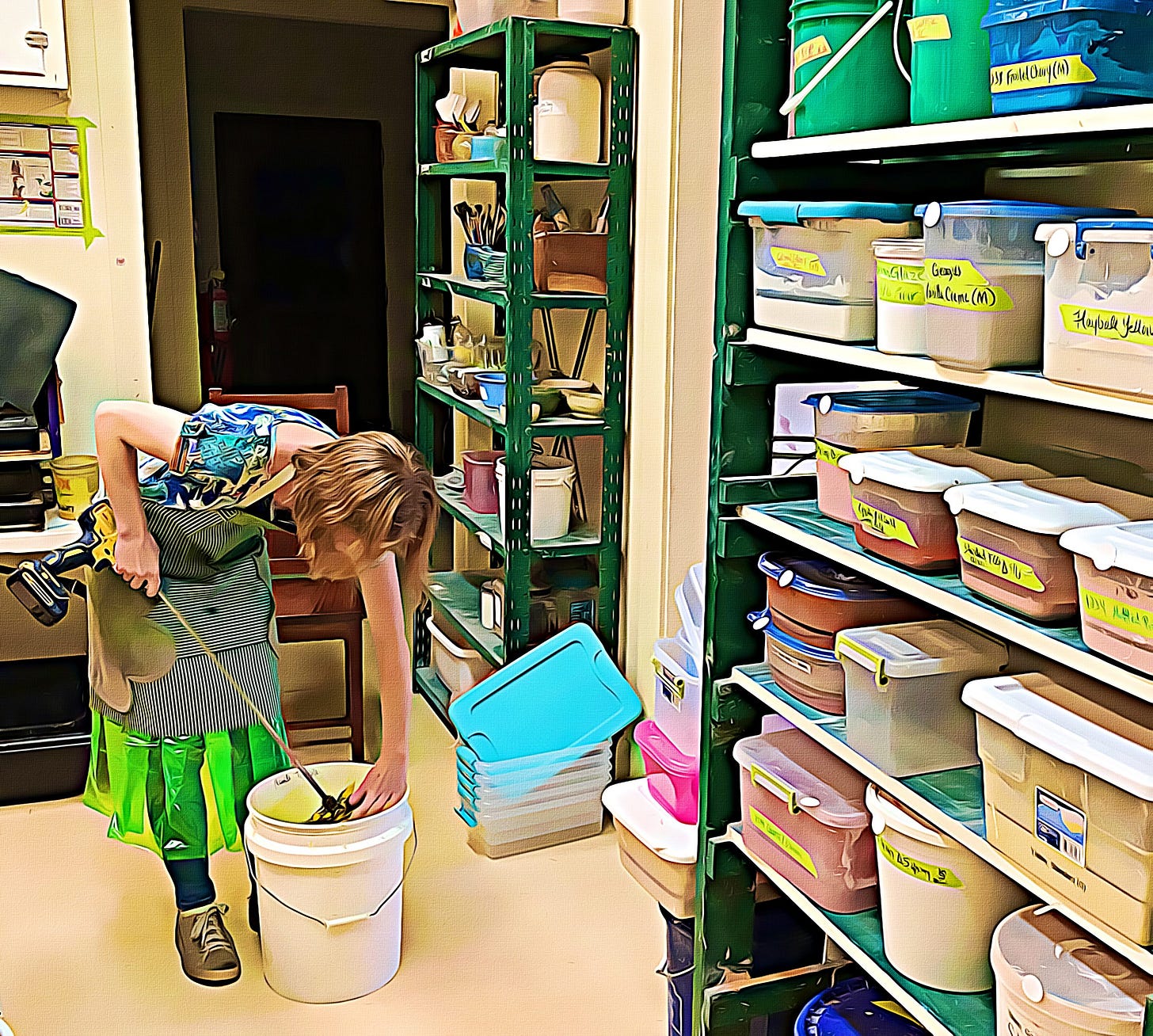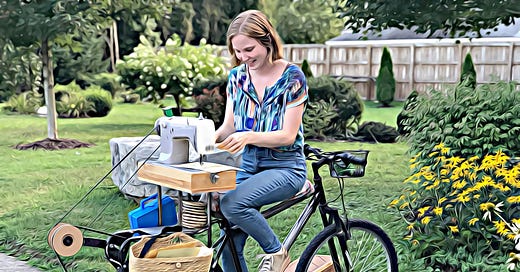FOLLOWING THE THREAD
Elkins, WV native Nevada Tribble weaves an unconventional career | Sep24, 2020

Nevada sits astride a bicycle-powered sewing maching she created to bring her artmaking into the community. | TFA Design Team colorized photo
Greetings. Here is our profile of Nevada Tribble, the final in a series of multimedia portraits of the five Emerging Artist Fellows of 2020 from across West Virginia, as chosen by Tamarack Foundation for the Arts (TFA).
Though not by design or intention, the work created by this year’s class of Fellows serves as a record of how artists deal with making art during a crisis. Through their work, they illustrate how the process of making art feeds the part of us that is resilient and alive with hope.
I am so grateful for the creative energy they’ve shared. And we’re proud to have the chance to showcase the creative endeavors of these five talented artists in a virtual exhibit opening October 15 at Taylor Books in Charleston WV.
Stay tuned to this newsletter and our Facebook page (facebook.com/groups/wvcreativenetwork) for details on that exhibit. It will occupy the physical space of the Annex Gallery at Taylor Books, but we'll be inviting anyone to visit it virtually as we play with and expand the possibilities of a ZOOM encounter with artists and their work. Actress, singer and avante-garde performer Ann Magnuson, a native of Charleston WV, will be introducing the show. Make sure you are subscribed to this free newsletter by adding your email at this address: tamarackforthearts.substack.com.
Be well. Stay Safe. Wear masks. Make art! | Renee Margocee, Executive Director, Tamarack for the Arts
Nevada Tribble is a native of Elkins WV and a graduate of Shepherd University in Shepherdstown, WV. She works in multiple art forms, all inspired by themes of landscape, place, and community. “Fiber arts are my primary media, in particular handmade paper and sewing,” she says. “I use handmade paper as a sculptural medium, while I use the sewing machine to draw with thread." She built a bicycle-powered sewing machine as a tool for drawing from life outdoors and a means of taking her creativity for a stroll into the community.

Braiden Maddox shoots Nevada at work (with a local onlooker) in the Elkins WV neighborhood where she grew up. She stitches an image of a porch in her field of view onto a piece of her handmade paper. | TFA Design Team colorized photo
1.
How has the pandemic and quarantine affected your work and creative output as an artist?
Even without the pandemic, this would have been a time of transition for me. I graduated from Shepherd University this Spring, finishing the last month of my degree online once campus shut down for the pandemic. For the first month or so, the shock of moving back to my hometown and entering a semi-quarantine left me pretty unmotivated to make work. I also had to shift my thinking from the large-scale installations I was working on at the time to smaller, more work-from-home friendly pieces, which was a difficult shift at first. However, now that I have adjusted to the situation, this has proved to be a peaceful and productive time for me. I was lucky enough to find studio space to rent at the Randolph County Community Arts Center in Elkins, WV. Having my own workspace has helped me regain inspiration.
2.
What has been the financial impact of the pandemic on the business aspect of your art production?
I was still a student when the pandemic started, so my art wasn’t much of a business yet. I have been establishing the business side of my art during the pandemic, so I don’t really know what it would have been like before. I consider myself lucky not to have been dependant on income from my art at the time of the shutdown.
Video by TFA Design Team member Braiden Maddox of Lady Mountain Films.
3.
What are you looking forward to in the year ahead?
I’m looking forward to spending more time in my studio developing my style and direction outside of the school atmosphere, and sharing this new work at my upcoming show at District Arts in Frederick, MD, next March. I have been enjoying doing a lot of sewn drawings lately, and it will be fun to explore those more. I am also looking forward to being able to take online workshops and pursue skills I am interested in such as weaving.

Nevada uses hardware store tools to mix and color paper pulp into a slurry. She’ll pour the mixture into a pan and press to craft her paper. | TFA Design Team colorized photo
4.
Do you think of who your audience is? If so, how might you describe that audience?
I think my audience is mostly focused on people who have experienced and loved Appalachia, but I think it could extend to anyone who has loved a certain place for its nature or community.
5.
If you could name an artist or creative person whom you would love to come to appreciate or know your work, who might that be?
I would love for Katherine Tzu-Lan Mann to be interested in my work. She is a painter from the Washington, DC area who makes large-scale, experimental painting installations I admire. They combine intricate botanical line work with abstract shapes and colors in such a beautiful unexpected way. In my mind, her work always evokes a narrative just out of reach.

Nevada uses paper pulp and a press to create squares of paper she’ll dry and later use in her artwork. | TFA Design Team colorized photo
6.
What words of encouragement, advice or hard-won insights might you have for fledgling artists—wondering whether it’s possible to turn pleasure for art into a more serious life commitment?
My advice to aspiring artists is to work on your writing skills. Being able to express your ideas fluently in writing is the key to helping people understand and value your work. That is what opens all kinds of doors and persuades people to buy your art, to show your work, or to give you opportunities. I think I have rewritten my artist statement about 12 times since the pandemic started. Most of the time, the process actually gives me more insight into the art I am making and what direction I want to move going forward.
7.
Ask yourself a question about art, the creative process or the business side of art— then answer it.
What motivates your work?
My work is motivated by a desire to share memories and stories of the strong connections in my life and the people I love—and the things that give me hope for a better world. I am very lucky to live in a beautiful area with a deep sense of community, and I want to share my love for this place and time. I also hope to inspire people to build community around themselves, because I believe that strong communities can solve many problems.
ONLINE ARTWORK:

Past multimedia profiles of the 2020 TFA Emerging Artist Fellows:
Jessie McClanahan's ceramic artistry draws from life in the hills: Sept. 10, 2020
The Cut-and-Past Symphonies of Psychoflauge: July 28, 2020
Portrait of the Emerging Artist: Jaci Rice: July 15, 2020
Portrait of the Artist in Her Studio and Out: Jes Reger: Jun 30, 2020
Spread the Word
Forward this free newsletter to artists and those who appreciate the arts. If the newsletter was forwarded to you, subscribe at: tamarackforthearts.substack.com. We generally publish two issues monthly, plus special themed issues.
Share comments below, call us at 304.926.3770, or e-mail me directly at renee@tamarackfoundation.org. For media inquires about stories on TFA Fellows or other topics, contact TFA team member Douglas John Imbrogno at info@tamarackfortherts.com.


